The Electric Glider Market is estimated to be valued at USD 551.0 million in 2025 and is projected to reach USD 1365.5 million by 2035, registering a compound annual growth rate (CAGR) of 9.5% over the forecast period.
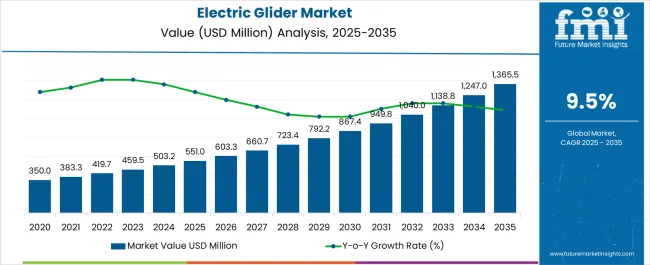
| Metric | Value |
|---|---|
| Electric Glider Market Estimated Value in (2025 E) | USD 551.0 million |
| Electric Glider Market Forecast Value in (2035 F) | USD 1365.5 million |
| Forecast CAGR (2025 to 2035) | 9.5% |
The Electric Glider market is experiencing significant growth driven by the increasing demand for sustainable and efficient aerial mobility solutions. The future outlook for this market is shaped by advancements in electric propulsion technology, lightweight materials, and battery efficiency, which collectively enhance flight performance and operational range. Growing environmental awareness and stringent emission regulations are encouraging the adoption of electric gliders across commercial and recreational aviation sectors.
Investments in research and development are facilitating innovations that improve safety, reliability, and energy efficiency, making electric gliders a more viable alternative to conventional aircraft. Additionally, the expanding use of unmanned aerial vehicles and urban air mobility initiatives is creating new applications and revenue streams for electric gliders.
Rising demand for cost-effective and low-maintenance flight solutions, coupled with supportive government policies for green aviation, further strengthens market expansion As industries increasingly focus on reducing carbon footprints and optimizing operational efficiency, electric gliders are positioned for sustained adoption in both established and emerging markets.
The electric glider market is segmented by platform, source, end-use industry, type, and geographic regions. By platform, electric glider market is divided into Rotary Wing Electric Glider and Fixed Wing Electric Glider. In terms of source, electric glider market is classified into Battery, Solar Cells, Fuel Cells, Ultra Capacitors, and Others. Based on end-use industry, electric glider market is segmented into Commercial and Military. By type, electric glider market is segmented into Manned and Unmanned. Regionally, the electric glider industry is classified into North America, Latin America, Western Europe, Eastern Europe, Balkan & Baltic Countries, Russia & Belarus, Central Asia, East Asia, South Asia & Pacific, and the Middle East & Africa.
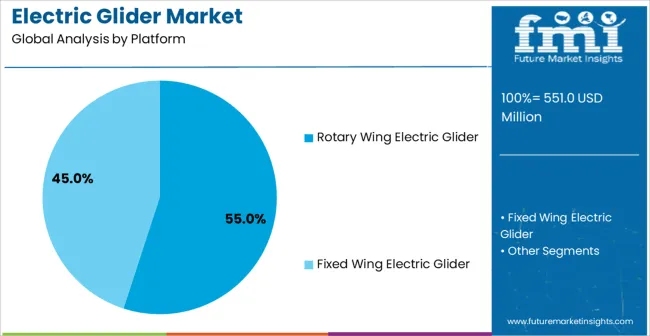
The rotary wing electric glider platform segment is projected to hold 55.0% of the market revenue share in 2025, establishing it as the leading platform. This growth is driven by the versatility and maneuverability of rotary wing designs, which enable vertical takeoff and landing as well as operation in constrained urban and remote environments.
The segment has benefited from advancements in lightweight materials and electric propulsion systems, which increase flight efficiency and payload capacity. Additionally, the capability to integrate modular systems and advanced control software enhances operational flexibility, making rotary wing electric gliders highly adaptable for various commercial and industrial applications.
Growing investments in urban air mobility and logistics solutions have further reinforced the adoption of rotary wing platforms Their ability to provide reliable, short-range flight solutions for commercial operations and specialized applications continues to support the segment’s leading position in the market.
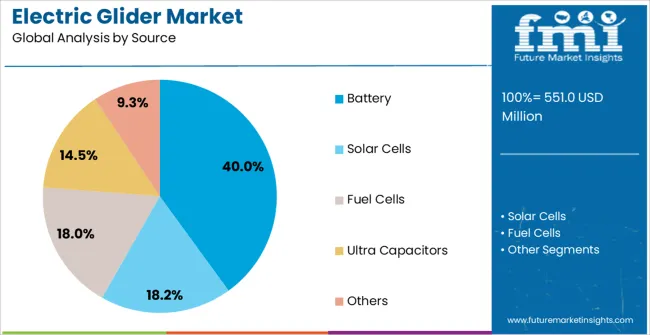
The battery source segment is expected to account for 40.0% of the Electric Glider market revenue in 2025, positioning it as the leading energy source. This growth is influenced by improvements in energy density, charging efficiency, and lifecycle performance of batteries, which enable longer flight durations and reduced operational costs.
The increasing focus on sustainability and the reduction of carbon emissions has accelerated the adoption of battery-powered propulsion in gliders. Technological advancements in battery management systems and modular battery design allow for safer, more reliable, and scalable energy solutions.
Additionally, regulatory support for green aviation initiatives and growing investments in electric propulsion research further drive the preference for battery-powered electric gliders The segment benefits from the rising demand for efficient and environmentally friendly aviation solutions across commercial and urban mobility applications.
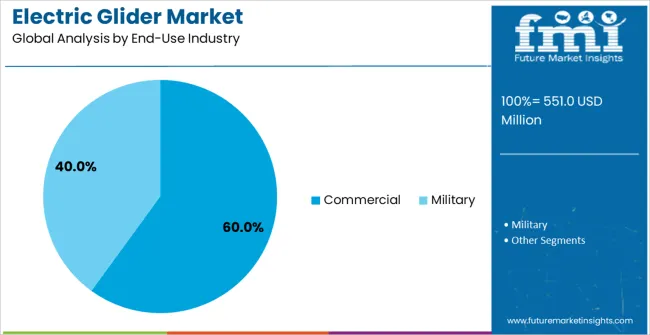
The commercial end-use industry segment is anticipated to account for 60.0% of the Electric Glider market revenue in 2025, making it the leading industry segment. This growth is propelled by the increasing demand for aerial solutions in commercial applications such as logistics, surveillance, urban air mobility, and passenger transport.
Electric gliders offer scalable and cost-effective flight solutions that can be tailored to the specific operational needs of commercial enterprises. The integration of advanced navigation systems and real-time monitoring enhances operational efficiency and safety, making them highly suitable for commercial deployments.
Furthermore, the growing emphasis on sustainable transportation and regulatory incentives for electric aviation solutions has accelerated the adoption of electric gliders in commercial sectors The ability to optimize operational costs while reducing environmental impact continues to drive the dominance of the commercial segment in the market.
An electric glider is basically an electric motor powered glider. In an electric glider, the source of electricity can be ultra-capacitors, solar cells, batteries, fuel cells and others. Electric Gliders are highly innovative products with respect to technology and functioning.
Generally, electric gliders are equipped with a propeller, which may be feathered (e.g. AMS-Flight Carat), fixed or retractable. Electric gliders are expected to find applications in many new electrical components, such as traction systems, structural components and light body composites.
This will provide economies of scale for the manufacturers of these components, which will decrease the manufacturing cost to some extent. This decrease in price is further anticipated to substantially boost the growth of the global electric glider market.
The global electric glider market growth is propelled by increasing usage of autonomous systems. Electric gliders have various advantages, such as low operational & maintenance cost, reduction in gas emissions and airport noise and others.
These advantages coupled with a tremendous increase in aircraft orders, bookings and deliveries are some of the other key factors supporting the growth of the global electric glider market demand over the forecast period.
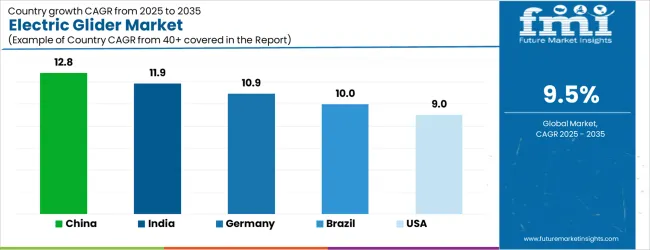
| Country | CAGR |
|---|---|
| China | 12.8% |
| India | 11.9% |
| Germany | 10.9% |
| Brazil | 10.0% |
| USA | 9.0% |
| UK | 8.1% |
| Japan | 7.1% |
The Electric Glider Market is expected to register a CAGR of 9.5% during the forecast period, exhibiting varied country level momentum. China leads with the highest CAGR of 12.8%, followed by India at 11.9%. Developed markets such as Germany, France, and the UK continue to expand steadily, while the USA is likely to grow at consistent rates. Japan posts the lowest CAGR at 7.1%, yet still underscores a broadly positive trajectory for the global Electric Glider Market. In 2024, Germany held a dominant revenue in the Western Europe market and is expected to grow with a CAGR of 10.9%. The USA Electric Glider Market is estimated to be valued at USD 190.8 million in 2025 and is anticipated to reach a valuation of USD 190.8 million by 2035. Sales are projected to rise at a CAGR of 0.0% over the forecast period between 2025 and 2035. While Japan and South Korea markets are estimated to be valued at USD 28.6 million and USD 13.8 million respectively in 2025.
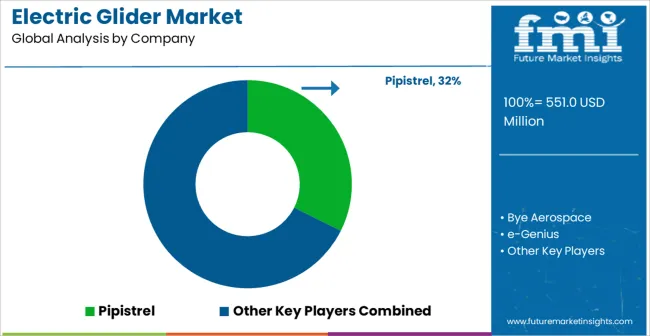
| Item | Value |
|---|---|
| Quantitative Units | USD 551.0 Million |
| Platform | Rotary Wing Electric Glider and Fixed Wing Electric Glider |
| Source | Battery, Solar Cells, Fuel Cells, Ultra Capacitors, and Others |
| End-Use Industry | Commercial and Military |
| Type | Manned and Unmanned |
| Regions Covered | North America, Europe, Asia-Pacific, Latin America, Middle East & Africa |
| Country Covered | United States, Canada, Germany, France, United Kingdom, China, Japan, India, Brazil, South Africa |
| Key Companies Profiled | Pipistrel, Bye Aerospace, e-Genius, eFlyer 2, LZ Design, Yuneec International, and Pipistrel Vertical Solutions |
The global electric glider market is estimated to be valued at USD 551.0 million in 2025.
The market size for the electric glider market is projected to reach USD 1,365.5 million by 2035.
The electric glider market is expected to grow at a 9.5% CAGR between 2025 and 2035.
The key product types in electric glider market are rotary wing electric glider and fixed wing electric glider.
In terms of source, battery segment to command 40.0% share in the electric glider market in 2025.






Our Research Products

The "Full Research Suite" delivers actionable market intel, deep dives on markets or technologies, so clients act faster, cut risk, and unlock growth.

The Leaderboard benchmarks and ranks top vendors, classifying them as Established Leaders, Leading Challengers, or Disruptors & Challengers.

Locates where complements amplify value and substitutes erode it, forecasting net impact by horizon

We deliver granular, decision-grade intel: market sizing, 5-year forecasts, pricing, adoption, usage, revenue, and operational KPIs—plus competitor tracking, regulation, and value chains—across 60 countries broadly.

Spot the shifts before they hit your P&L. We track inflection points, adoption curves, pricing moves, and ecosystem plays to show where demand is heading, why it is changing, and what to do next across high-growth markets and disruptive tech

Real-time reads of user behavior. We track shifting priorities, perceptions of today’s and next-gen services, and provider experience, then pace how fast tech moves from trial to adoption, blending buyer, consumer, and channel inputs with social signals (#WhySwitch, #UX).

Partner with our analyst team to build a custom report designed around your business priorities. From analysing market trends to assessing competitors or crafting bespoke datasets, we tailor insights to your needs.
Supplier Intelligence
Discovery & Profiling
Capacity & Footprint
Performance & Risk
Compliance & Governance
Commercial Readiness
Who Supplies Whom
Scorecards & Shortlists
Playbooks & Docs
Category Intelligence
Definition & Scope
Demand & Use Cases
Cost Drivers
Market Structure
Supply Chain Map
Trade & Policy
Operating Norms
Deliverables
Buyer Intelligence
Account Basics
Spend & Scope
Procurement Model
Vendor Requirements
Terms & Policies
Entry Strategy
Pain Points & Triggers
Outputs
Pricing Analysis
Benchmarks
Trends
Should-Cost
Indexation
Landed Cost
Commercial Terms
Deliverables
Brand Analysis
Positioning & Value Prop
Share & Presence
Customer Evidence
Go-to-Market
Digital & Reputation
Compliance & Trust
KPIs & Gaps
Outputs
Full Research Suite comprises of:
Market outlook & trends analysis
Interviews & case studies
Strategic recommendations
Vendor profiles & capabilities analysis
5-year forecasts
8 regions and 60+ country-level data splits
Market segment data splits
12 months of continuous data updates
DELIVERED AS:
PDF EXCEL ONLINE
Electric Aircraft Onboard Sensors Market Size and Share Forecast Outlook 2025 to 2035
Electrical Label Market Size and Share Forecast Outlook 2025 to 2035
Electric Round Sprinklers Market Size and Share Forecast Outlook 2025 to 2035
Electric Cloth Cutting Scissors Market Size and Share Forecast Outlook 2025 to 2035
Electrical Insulation Materials Market Size and Share Forecast Outlook 2025 to 2035
Electric Aircraft Sensors Market Size and Share Forecast Outlook 2025 to 2035
Electric Traction Motor Market Forecast Outlook 2025 to 2035
Electric Vehicle Sensor Market Forecast and Outlook 2025 to 2035
Electric Vehicle Motor Market Forecast and Outlook 2025 to 2035
Electric Off-Road ATVs & UTVs Market Size and Share Forecast Outlook 2025 to 2035
Electric Blind Rivet Gun Market Size and Share Forecast Outlook 2025 to 2035
Electric Fireplace Market Size and Share Forecast Outlook 2025 to 2035
Electric Vehicle Battery Conditioners Market Size and Share Forecast Outlook 2025 to 2035
Electric Power Steering Motors Market Size and Share Forecast Outlook 2025 to 2035
Electric Motor Market Size and Share Forecast Outlook 2025 to 2035
Electric Gripper Market Size and Share Forecast Outlook 2025 to 2035
Electric Boat Market Size and Share Forecast Outlook 2025 to 2035
Electric Bicycle Market Size and Share Forecast Outlook 2025 to 2035
Electric Vehicle Transmission Market Size and Share Forecast Outlook 2025 to 2035
Electrical Enclosure Market Size and Share Forecast Outlook 2025 to 2035

Thank you!
You will receive an email from our Business Development Manager. Please be sure to check your SPAM/JUNK folder too.
Chat With
MaRIA